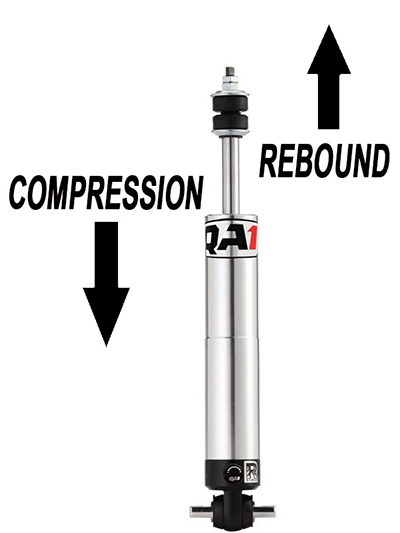Our friends at QA1 sent over this new tech story to help racers determine valving on QA1’s adjustable shocks. Read the full story below!
You made the purchase and bought some QA1 adjustable shocks and installed them on your vehicle. Now the question is, how do I determine the right valving?
QA1 shocks have either 1 or 2 knobs. Each knob has 18 damping settings; there are 6 clicks per revolution, and each knob has 3 complete revolutions. This gives you many possible valving options.
Adjusting them for your vehicle and intended driving style is easy! Let’s walk you through it.
Understanding Compression and Rebound
Before we begin, we should breakdown the terminology of compression and rebound. This terminology refers to the two directions a shock can move. The compression stroke is the action of the shock’s piston rod compressing into the shock body. Opposite of that, when the piston rod extends back out of the body, this is the rebound stroke.

What Do the Knobs Adjust?
Now that we understand compression and rebound, let’s dive into what the knobs do and why they’re important. QA1 shocks are a hydraulic twin-tube design that moves fluid throughout the shock when it extends and compresses. Turning the knob will either restrict this fluid travel or open it up. On the vehicle, this will result in a firmer or softer ride quality.
You will notice on the bottom of your shock you will have one knob, or two. If you have one knob, the adjustment will be for either the rebound only or rebound and compression simultaneously. Moving the piston rod in and out by hand will quickly identify which shock you have.

If you have two knobs, compression and rebound will be independently adjusted. That means, if you adjust the knob with a “C” on it, only the compression will change. If you adjust the knob with an “R” on it, only the rebound will change.
Which valving setting is right for me?
Set the knob fully counterclockwise. This is the softest setting (“0 Clicks”), so it acts as a base level to work from. Using the recommended settings below, start testing your ride and handling. Turn the knob clockwise to make the shock stiffer or turn it back counterclockwise to make it softer. Starting at “0” and incrementally stiffening the shock minimizes guesswork so you can truly dial in your ideal performance.
|
|
Single Adjustable Shocks |
Double Adjustable Shocks |
Double Adjustable Shocks |
| Front Shocks |
Compression |
Rebound |
|
|
Drag Racing |
0-6 Clicks |
12-18 Clicks |
0-6 Clicks |
|
Nice Ride & Handling |
0-6 Clicks |
0-6 Clicks |
2-8 Clicks |
|
Firm Ride & Improved Handling |
6-12 Clicks |
6-12 Clicks |
8-14 Clicks |
|
Aggressive Handling |
13-18 Clicks |
13+ Clicks |
14-18 Clicks |
|
Rear Shocks
|
|
|
|
|
Drag Racing
|
4-10 Clicks |
0-6 Clicks |
4-10 Clicks |
|
Nice Ride & Handling |
0-6 Clicks |
0-6 Clicks |
2-8 Clicks |
|
Firm Ride & Improved Handling |
6-12 Clicks |
6-12 Clicks |
8-14 Clicks |
|
Aggressive Handling |
13-18 Clicks |
13+ Clicks |
14-18 Clicks |
We hope this article was helpful for you! If you have any questions, please feel free to give us a ring at (952) 985-5675 or shoot us an email.


























